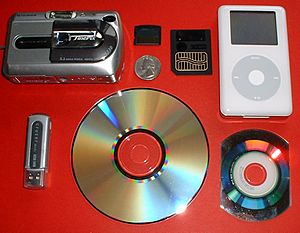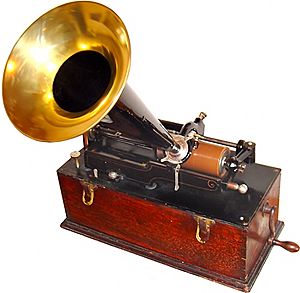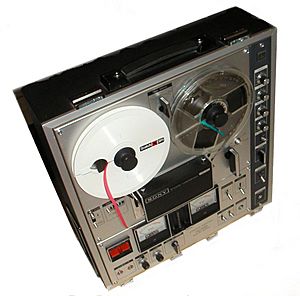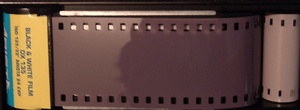Data storage device facts for kids
A data storage device is a special tool that helps us save information, also known as data. Think of it like a digital notebook or a super smart filing cabinet! We can save data using almost any kind of energy. People have been storing data for thousands of years, even with simple pictures and writing.
Modern storage devices can hold information, process it, or do both. When we talk about data storage devices today, we usually mean those used with computers. These devices can keep your data, like files, safe for a long time.
Electronic data storage means saving data using electricity. You need electricity to put data onto these devices and to get it back. Most storage devices that don't need you to visually see the data to read it fall into this group. Electronic data can be stored in either an analog (like old record players) or digital (like computer files) format.
Contents
How Data Storage Devices Work
Any device that can write information onto a storage material and then read it back can be called data storage equipment. These devices use different ways to hold data:
Portable Storage Methods
These are storage methods where you can easily remove the storage part. You can take your data with you!
- Hand crafting: Like drawing or painting.
- Flat surfaces:
- Printmaking: Making copies of images or text.
- Photographic prints: Pictures saved on paper.
- Fabrication: Creating things, like with textiles (cloth).
- Cylindrical accessing: Like old phonograph cylinders.
- Memory card readers: For memory cards from cameras or phones.
- Tape drives:
- Mono reel or reel-to-reel tapes: Long strips of tape.
- Compact Cassette players: For music tapes.
- Disk drives:
- Disk drives: For computer hard drives.
- Floppy disks: Older, flexible disks.
- Cartridges: Like game cartridges for consoles.
- Flash memory devices: Small, portable drives you plug into a computer.
Built-in Storage Methods
These methods are usually inside a device and are not meant to be removed often. Sometimes you might need tools to get to them.
- Hard disk drives: The main storage inside many computers.
- Non-volatile RAM (NVRAM): Special memory that keeps data even when the power is off.
Temporary Storage Methods
These methods lose their data when the device is turned off or disconnected.
- Volatile RAM: This is your computer's short-term memory. It's super fast but forgets everything when you turn off the computer.
What is a Recording Medium?
A recording medium is the actual physical material that holds the data. It's where the information is saved! For electronic media, the data and the medium are sometimes called "software," but that word usually means computer programs.
Old and Timeless Examples

- Optical:
- Any object that can be seen, used to mark a place.
- Any crafting material used to make shapes, like clay, wood, metal, glass, or wax.
- Quipu: Knotted strings used by ancient Incas to record information.
- Any surface that can be marked with heat, like for branding animals.
- Any marking material like paint, ink, or chalk.
- Any item that can hold a marking substance, such as papyrus, paper, or skin.
- Chemical:
Modern Examples by How They Store Data
- Chemical:
- Dipsticks: Used to measure things and show results.
- Photochemical:
- Photographic film: Like the film used in old cameras to capture images.
- Mechanical: These use physical changes to store data.
- Pins and holes:
- Punch cards: Cards with holes punched in specific patterns.
- Paper tape: Long strips of paper with holes.
- Music rolls: Used in player pianos.
- Music box cylinders or disks: Have pins that play notes.
- Grooves:
- Phonograph cylinders: Oldest way to record sound.
- Gramophone records: Vinyl records with grooves.
- Pins and holes:
- Magnetic storage: Uses magnetic fields to save data.
- Wire recording: Uses a thin stainless steel wire.
- Magnetic tape: Used in video and audio cassettes.
- Floppy disks: Older computer disks.
- Optical storage: Uses light, often lasers, to read and write data.
- Photo paper: For printing photos.
- X-rays: Medical images.
- Holograms: 3D images made with lasers.
- Optical discs: Like CDs, DVDs, and Blu-ray Discs.
- Electrical: Uses electricity to store data.
- Semiconductors in volatile RAM microchips: Fast but temporary memory.
- Floating-gate transistors in non-volatile memory cards: Keep data even when power is off.
Modern Examples by Shape
We can also group storage media by their shape and how they move (or don't move) when data is read or written.
- Paper card storage:
- Punched cards: (mechanical)
- Tape storage: Long, thin, flexible strips that move in a line.
- Paper tape: (mechanical)
- Magnetic tape: (magnetic)
- Disk storage: Flat, round objects that spin.
- Gramophone records: (mechanical)
- Floppy disks, ZIP disks: (magnetic, removable)
- Optical discs: Like CDs, DVDs, Blu-ray Discs.
- Hard disk drives: (magnetic)
- Flash memory/memory card: Solid-state (no moving parts) electronic memory.
- xD-Picture Card
- MultiMediaCard
- USB flash drives (also called "thumb drives" or "keydrives")
- SmartMedia
- CompactFlash I and II
- Secure Digital (SD) cards
- Sony Memory Stick
- Solid-state drives (SSDs): Fast, modern computer storage with no moving parts.
Related Pages







